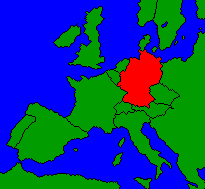  The Nineteenth-Century
|
|
In many ways German organ builders of the nineteenth century followed the same paths taken by their counterparts in England and France. Instruments were larger than they had been before, and they played on higher pressures. Inevitably, higher pressures required the use of some form of pneumatic assist to allow ease of playing, and Cavaillé-Coll's Barker machines provided the model for most German builders. Other mechanical developments during the nineteenth century also paralleled those in France and England, and German organs of the second half of the century were equipped with combination pedals that allowed the organist to make stop changes while playing. By the end of the century adjustable combination pedals of a type similar to those used in England were common, and you will see them listed in organ dispositions and specifications as Frei Kombinationen (free combinations), the term Frei indicating they were adjustable. Just as the French adaptation of the Barker lever influenced German instruments, so, too, did the harmonic flutes and trumpets of Cavaillé-Coll find homes in instruments of later nineteenth-century Germany. This does not mean that German instruments of this period were conceived as imitations of the Cavaillé-Coll organ, however. They formed as distinct a national type of musical instrument in the nineteenth century as they had in the seventeenth or eighteen centuries, and some of the characteristics of the earlier periods still influenced the thinking of German builders throughout the Romantic period. If you look back at earlier German instruments that are described in this tutorial, you will see some of those characteristics in their stoplists. Silbermann organs of the eighteenth century, for example, often include a variety of color stops at 8' pitch on a single manual. The practice of building different pipe shapes, particularly flue pipes, in order to produce different tone colors can be found in earlier German organs, a characteristic you will see even in the "Praetorius organ." This variety of tone color in flue pipes within a given pitch level continued in the nineteenth century and is one of the most striking characteristics of the German Romantic organ. As you study the stoplists of the instruments described on the accompanying pages of this tutorial, be sure that you notice the variety of stop names at 8' pitch on any given manual. You will find many stop names that will be familiar to you - - Prinzipal, Bordun, or Gedeckt, for example. You will also see new stops, some of which you have never seen even on organs you might have played - - Harmonika, Prinzipal amabile, Lieblich Gedeckt. These stop names, even though they seem fanciful to us over 100 years later, represent specific types of pipe construction, each one selected to produce a distinct tone color. Some were designed to produce the new forceful sounds that we find on French and English instruments of the nineteenth century. Others, however, were built to produce finely distinguished quiet sounds, and you might even find several different soft stops on a single division. One reason for a greater variety of quiet sounds on German instruments is the rather late adaptation of the Swell enclosure in German organs. Even in the late nineteenth century, organs were built with only a few stops enclosed in a Swell box. The variety of soft stops meant not only that the high degree of dynamic shading that characterizes much Romantic music was possible on these instruments, but also that that goal could be accomplished without building large swell enclosures for entire divisions. In summary, you should expect to find these characteristics in a nineteenth-century German organ.
© 2000 AD James H. Cook |